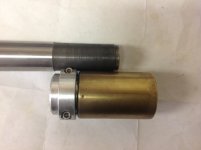Ken, I can understand why you and so many others have a hard time visualizing what I have said for years about the rifle going out of tune because air thins out and weighs less as ambient temp increases. Your sentence above,
"Air in the barrel thinning throughout the day"
tells me that you are thinking only of that tiny bit of air 'in-the-barrel' and the insignificant weight it represents. Forget about that; if that's all there was to it the concern would indeed be negligible, but what you are overlooking is the fact that the air 'in-the-barrel' is confined in a long cylinder (the barrel) and the bullet (the piston) must push the contents out against the entire weight of the atmosphere and is travelling at around mach 2.7 by the time it exits the muzzle!
You can just imagine the backpressure this compressed air in the barrel exerts on the bullet as it accelerates down the bore toward the muzzle! The heavier the atmosphere, the more backpressure it exerts. If the atmosphere warms and air becomes less dense, backpressure on the bullet decreases, it accelerates quicker which reduces in-bore time and the bullets begin to exit early. That's why speeding the barrel up slightly (increasing vibration frequency) puts the rifle back in tune.
Hope this helps.
Gene Beggs
Not sure.
If I understand what you are saying is a less dense bore air increases muzzle velocity which to me seems contrary to the Pressure Exponent factor whereby a less dense air in front of the bullet (less confinement) would lower pressure and burn rate. - Negligible value.
As I see it, it is the higher operating temperatures ( lower bore gas densities) increasing energy produced. Pressure change per unit of time is directly proportional to Temperature. – High value.
All else being equal and not mentioning blow-by gases changing bore gas densities.
BR
Ken


